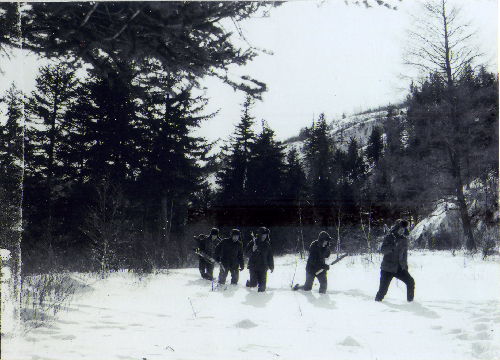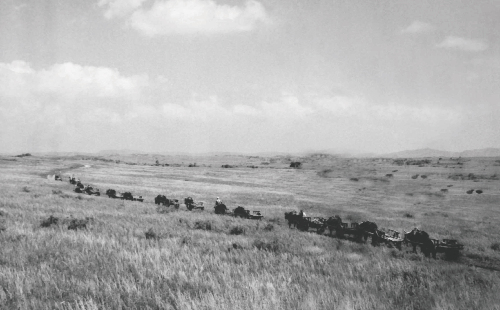By Li Xia
In 1681, Emperor Kangxi of the Qing Dynasty (1644-1911) commissioned the formation of the Mulan Hunting Ground for the royal family to “display martial merit, pacify vassal states and hold hunting parties.” The vast expanse of pine trees had been a popular royal hunting ground since the Liao (907-1125) and Jin (1115-1234) dynasties. About 400 kilometers from Beijing, Mulan Hunting Ground is still home to defense forests, lush pastures and a variety of wild animals. The Saihanba Mechanical Forest Farm of Hebei Province now resides on the former imperial hunting ground.
In 1863, the second year of the reign of Emperor Tongzhi, the Qing government launched the first large-scale logging and reclamation campaign in Mulan Hunting Ground to solve its fiscal problems. Over the following 53 years, nearly 10,000 hectares of forest was destroyed and developed into farmland. By the time the Qing Dynasty collapsed, the formerly primitive forests, pastures and rivers in the area had deteriorated into barren deserts.
Beijing lost a natural shield, and sandstorms from the Inner Mongolia Plateau began pummeling the Chinese capital. The city often became blanketed in sand in springtime.
In 1961, the Ministry of Forestry dispatched a group of experts to Saihanba to explore the possibility of artificial forestation there. By then, the People’s Republic of China was only in its 12th year, and the national economy was still struggling to gain traction. But the Chinese government understood the importance of forests and was committed to creating a state-owned forest farm there to restore the destroyed vegetation. In February 1962, the Chengde Saihanba Mechanical Forest Farm under the Ministry of Forestry was established, heralding the dawn of a mammoth artificial forestation program in northern China and a return of reverence for our mother earth.

Sacrifices
The first generation of workers at the Saihanba forest farm made incredible sacrifices in an attempt to undo the historical wrongs.
In the early days of the forest farm, the Ministry of Forestry mobilized 127 graduates of 24 colleges, universities and vocational schools nationwide to reinforce the forest farm’s technical know-how, and before long, a 369-member afforestation team was set up.
Winter temperature in Saihanba can drop to as low as negative 40 degrees Celsius, and a heavy spell of snow would simply cut it off from the outside world. In those days, the primary means of transport were horse or oxen-pulled carts, and a 100-kilometer journey would take several days. Locals dwelled in earthen houses or tents and had to remain vigilant against howling wolves. When waking up in the morning, most residents would find a thin layer of frost on their eyebrows and hair.
“Production over life” was a common slogan everywhere during the early period of China’s socialist construction. Saihanba was no exception. Despite the harsh natural conditions and poor living standards, the principle served as the driving force for many.
By 1982, some forests in the area had been restored. However, not until recent years did local living and education conditions substantially improve. Prior to the 1980s, inhabitants of the forest farm didn’t send any children to college due to underdeveloped educational facilities. “In fact, even the second generation sacrificed a lot,” noted a worker of the forest farm.
Natural disasters are the worst enemies of planted forests, and they often nullified years of human efforts. Many workers still remember the catastrophic glaze of frost on October 28, 1977: After a few days of rain and low temperatures, the trees were coated by thick ice, and many branches broke due to the weight. The frost destroyed more than 13,000 hectares of forests. In 1980, about 8,000 hectares of forest were lost to a severe drought.
Wildfires are another threat. The forest farm has nine fire lookout towers, of which eight are manned by husband-wife teams. In such remote places, couples have a better chance of enduring extreme isolation. These observers make unimaginable sacrifices. Chen Ruijun and his wife Chu Jingmei have worked in one of these watchtowers for 12 years, making lookout reports every 15 minutes. Life there is lonely and boring, especially for their eight-year-old son who can barely speak fluently due to a lack of practice.
The blood, sweat and tears of generations of afforestation workers have eventually forged the spirit of Saihanba to be praised by the nation.

Reconciliation
Late Chinese leader Mao Zedong once wrote in a poem: “Bitter sacrifice fuels bold resolve, which dare ignite the sun and moon in new skies.” To transform Saihanba from a desert into an oasis, locals have made great sacrifices.
By 1982, workers on the forest farm had planted 320 million trees covering 64,000 hectares of land, with a survival rate of over 90 percent.
Liu Jun and his wife now operate a fire lookout tower. They still remember planting trees as children. Back in the 1970s, many students in fifth grade or above joined in the tree-planting campaign during summer vacations, through which they earned tuition and boarding fees. Local farmers also participated in for extra income.
Scientific and technological progress provided a guarantee for the environmental restoration of Saihanba. Since 1962 when the first trials began, technicians at the forest farm have accomplished significant technological innovation and crossbreeding. Not only have they cultivated many new species that resist the cold and more effectively thwart sandstorms, but also renovated machinery to enhance the quality and speed of forestry work. By 1964, the survival rate of the forest farm’s 34.4 hectares of planted larches rose to over 90 percent, an impressive increase from eight percent in only two years.
From the vision and courage of the first generation of Communist Party of China (CPC) leaders to foresee the importance of environmental protection to the concept of green development recently introduced by Chinese President Xi Jinping, who stressed that “building an ecological civilization concerns people’s wellbeing and the future of our nation,” Chinese people from all walks of life are working even more conscientiously on creating harmonious coexistence between man and nature.
“We developed an awareness of forest protection when we were children,” declares Wang Chong, a third-generation resident of the Saihanba forest farm. “For us, forests are our home and family. We consider every tree our own child.” Her grandparents served as first-generation workers of the forest farm after attending the Secondary Forestry School in Baicheng.
Through unimaginable sacrifice, residents of Saihanba have eventually restored the natural environment that was once destroyed.
Coexistence
Mother Nature repays humans who treat her well.
The word “management” can mean a wide variety of things depending on context, and in Saihanba, it alludes to preserving and expanding forests.
Local achievements in forest management are backed by numbers: From 1962 to the end of 2016, Saihanba’s forested areas increased from 16,000 hectares to nearly 75,000 hectares, forest coverage rate from 18 percent to 80 percent, and total timber reserve from 330,000 cubic meters to a whopping 10.12 million cubic meters.
The Saihanba ecosystem, comprised of forests, grasslands and wetlands, is home to 261 species of wild terrestrial vertebrates, 32 species of fish, 660 species of insects, 179 species of large fungus and 625 species of plants. Of them, 47 animals and nine plants are under state-class protection.
Frostless days each year have grown from 52 to 64, while the number of extremely windy days has dropped from 83 to 53. Back in the 1950s, Beijing had an average of 56.2 sandstorm days each year. In recent years, the annual volume of sandstorm days in the city has decreased by more than 70 percent.
Large-scale forestation has also created many jobs for locals and stimulated the development of supporting industries such as rural tourism, animal husbandry, handicrafts and transportation. These sectors create additional revenues of over 600 million yuan, which have been helping locals shake off poverty.
Since its establishment, the Saihanba forest farm has realized 73 research achievements in nine categories including seed breeding, forestation, forest management, pest control and secondary products.
Man has taken a painful lesson to learn how to live in harmony with nature. Chinese President Xi Jinping, also general secretary of the CPC Central Committee, stressed that we must “raise awareness of the need to respect, accommodate and protect nature, place a high priority on ecological progress, work hard to build a beautiful country and achieve lasting and sustainable development for the Chinese nation.” Only by making environmental protection a goal rather than an inconvenience can peaceful coexistence of man and nature and sustainable development be achieved.
The author is executive editor-in-chief of China Pictorial.